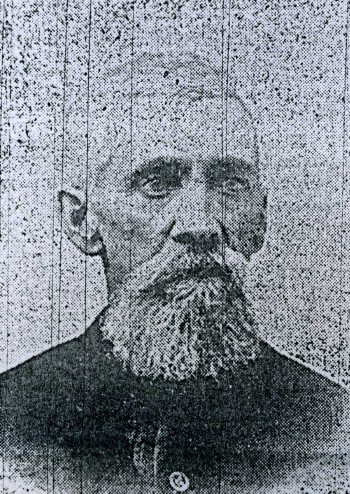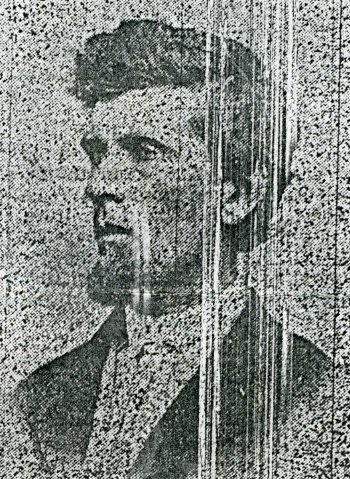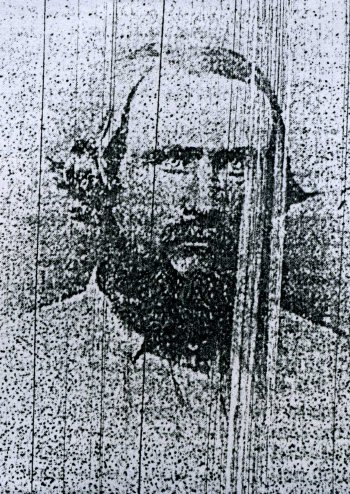Hon. B.F. Langworthy of Brownsdale,
One of the
Earliest Settlers of the County,
Continues His Series of
Interesting Articles.
LANSING, 103, 18, was quite well supplied with timer along
the Cedar river when the county was first settled, which was mostly cut for
building purposes. There is still considerable second growth timber in the
township. The first to make settlement in the township was H.O. Clark,
known as "Hunter Clark," a name given him from his being an expert hunter.
He came in the fall of 1853, He settled on the northeast quarter of section
34 and built a cabin a short distance from where Oakwood cemetery is now
located. Clark was of the true pioneer stamp; could not stand crowding.
He sold his claim to Wm. Baudler, who took possession May 8, 1855. Clark
went to Idaho. Samuel Clayton located on sections 26 and 27 in 1854.
He worked at blacksmithing in connection with his farming until 1865, when
he sold his claims to Michael Teeter and left for Kansas.

Abraham S. Lott, Came to Austin Township in 1854
N.G. Perry came in 1854. He was accompanied by Samuel
Dixon. Mr. Perry sold his farm to C. P. Bell and left for Nebraska. John
Petibone entered three eighties in section 11 in 1854 and in 1857 he sold
out to A.B. Vaughan and D.M.V. Stewart and returned to Ohio. A.B. Vaughan
came to the county in company with two sons in the fall of 1854. They took
claims in section 10. After letting the contract for building a home they
returned to Wisconsin for the winter. In the spring of 1855 Mr. Vaughan with
his family, accompanied by his five grandsons, two of whom were married,
came with teams to their new homes in Mower county. The sons of Mr. Vaughan
are Phineas D., John G., Enoch G., Herman B. and Benjamin R. Phineas D.
located on southeast quarter of section 3, John G. in the southeast quarter
of section 2, Enoch G. on the northeast quarter of section 10, Herman B. on
the southeast quarter of section 10, John G. and Phineas D. resided in the
village. In September 1855 D. B. Vaughan preempted the northwest quarter of
sectin 15. He enlisted in 1862 in company C, 9th Minnesota Volunteers Infantry,
serving until August 1865.
Among the settlers of 1856 were Thomas Gibson, William
Rutherford, John P. and Harcar Lyon, John H. Watkins, Henry C. Aldrich, Joseph
Gillen, Martin McNally, Joseph Smith, James McLaughlin, Alfred Bartlett and
John Dignan, and among those that came in later are George Wood, John
Mathieson, Anson C. Boyonton, Wm. Litchfield, Jones Haney, E. H. Nellis and G.
W. Grimshaw. Wm Rutherford came into the township August 10, 1856. He entered
the east half of the northeast of section 14.
Harker Lyons in 1856 came to Mower county with his two sons
Harker and John P. John P. took a claim of 160 acres, after which he divided
with his brother Harker, who enlisted November 1, 1863, in Company B, Second
Minnesota Cavalry, serving until December, 1865, when he was honorably
discharged.
Jones Haney in 1856 settled on section 30 of this township,
where he resided for many years. John H. Watkins in 1856 came to the county
and settled in Lansing. William M. Litchfield came the same year with his
wife and settled in section 34. His farm contains 250 acres. Lars Thorson,
better known as Lewis Thompson, in 1856 came into the county and preempted
a quarter section in section 7. Henry C. Chapin in the spring of 1871 returned
to this county and settled in the township.
Azariah H. Chapin came in 1856. In 1862 he enlisted
in Company C. Ninth Minnesota Infantry Volunteers, and
served until the close of the war. In 1870 he moved onto and commenced
improving the land which he preempted in 1856 in sections 21 and 28. James
N. Cook came to the county in 1856 and purchased a farm in Lansing township.
Robert Lewis came to Minnesota in 1864 and settled in this township
where he preempted a farm where he lived alone for three years.
Christopher P. Bell settled in the town in 1857. He is one of
the largest land owners in the township. John Mathison in the spring of
1858 came to the county and settled on the farm on which he still resides
in the township at Ramsey.
Anson C. Boyonton came into the county in 1859 on Sept.
20. He moved on a farm in sections 27 and 34. Matthew Greg____
in 1872 built the Ramsey mill, of which he was proprietor and owner until
his death. Among those who have come to the town who have been identified
with its history are G.W. Grimshaw and A.P. McBride. George Cornelveaux
moved upon his farm in 1861. Michael Teeter in 1857 moved to Mitchell
county, Iowa, remaining until the fall of 1860. He voted for Lincoln in
the forenoon and moved across the line into Mower county in the afternoon
and settled in section 29 in Lyle township, where he lived until April
1865, when he moved to his present farm in Lansing township, which contains
330 acres with good buildings.
Ole G. Anderson came to the county and made his home
with H.B. Oleson on section 6 in Lansing township. He later bought
the farm on which he now resides.
Anson W. Garrard moved in 1874 to a farm on section 33. John Thompson in
1862 came to the village of Lansing and purchased the farm on which he now
resides. Frank Hangge in 1872 bought two lots in Austin and with four cows
commenced his present dairy business. In 1874 he purchased this present
farm northeast of Austin. The township was organized in April, 1858.
George Wood in March, 1857, came into the county and preempted a quarter
section in section 8 and 9 in Lansing township. He was for years one of the
large and ____ of the township, owning 520 acres, all under cultivation.
The C. M. & St. P. railway company in October, 1867, built their road
through the township, entering the town in section 3 and crossing into
Austin. The Southern Minnesota railroad was built through the township
in 1869 and 1870. The road enters the town in the southeast corner of
section 13 and runs in a southwesterly direction through sections 4 and 23,
in which latter section it forms a junction with the C. M. & St. P.
railroad at Ramsey.
AUSTIN TOWNSHIP, was one of the first settled townships
in the county. Austin Nichols came to the present site of Austin in 1852
or 1853 and as early as 1854 Jackson Wilder laid claim to a large tract of
land east of the Cedar River in the vicinity of where Officer's mill site is.
This included what was known as the Sweetwater claim, so called from its
beautiful spring there. He did not stay but pushed on to the Otranto
neighborhood.
In September, 1854, C. H. Huntington, A. S. Lott, Calvin
Powers and Moses Rolph came from Rock county, Wisconsin, seeking a location.

Charles H. Huntington, Came to Austin Township in 1854
As the Wilders were not living on the Sweetwater claim,
Huntington and Lott bought it. They went up to the present site of Austin
and met Chauncy Leverich, who had bought out Nichols, and they offered him
$450 for his claim. He insisted on $500 and the bargain was not made. The
party returned to Wisconsin for the winter, but fearing that their claims
might be jumped in their absence, Calvin Powers and family and Huntington
came and spent the winter here. They arrived at Sweetwater claim Nov.
18, 1854 making the trip of 250 miles with a pair of horses and wagon. They
drove a cow with them and brought household goods and a stock of provisions
for the winter. A log house was put up, 12 x 15 with one window and a door,
a roof of oak shacks and with the cracks between the logs filled with chips
and mud plaster. Here Mr. Powers with his wife and four children spent the
winter. One day in February, while Mr. Powers and family were away from
home Indians broke into their cabin and stole their provisions but they
were kindly supplied by friends at Otranto, and the winter passed with
little suffering.
April 15, 1855, Huntington and Lott, whose wives were
sisters, started from Wisconsin and reached Austin township May 6, having
made the trip with eight pair of oxen and two wagons. They also brought 48
head of cattle and 44 hogs. George Bemis and John Osborn joined them in
Howard county. They brought a cast iron mill for grinding meal with them,
which was the first in use in Mower county, and was a great convenience for
settlers within a wide area. Lott settled on section 27 and Huntington took
the Sweetwater claim. Both had spent several years previous in California
making an overland trip, which in those days meant danger and exposure.
David L. Chandler also came out from Wisconsin in 185__, and
settled near what was later Cedar City. Powers settled on section 25, where
he died.

Calvin Powers, Came to Austin Township in 1854
In 1855, among others who came to Austin township were: Robert
Audis, who settled on Section 10 and opened his house for a hotel with a dance
hall in connection; Alexander Nigus, who settled on Section 1, on land now
owned by J.S. Decke; George and Thomas Phelps, who settled in the Cedar City
neighorhood; Reuben and Levi Watrous and Widow Lockwood on Section 12, Clem
Smith on section 23, Daniel McPherson and M. J. Woodson
B.F. Langworthy
(To be continued)
Mower County Transcript, Wed.,
May 7, 1902, page 5, col. 1-3
|